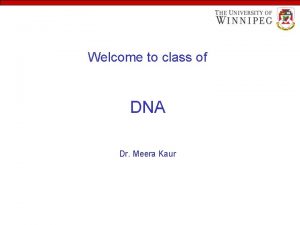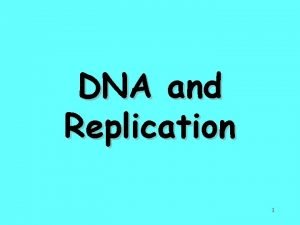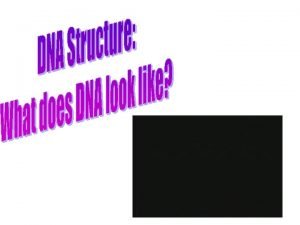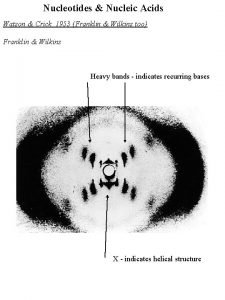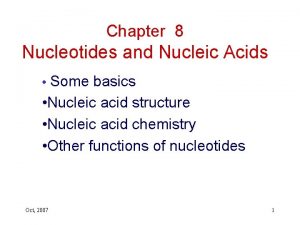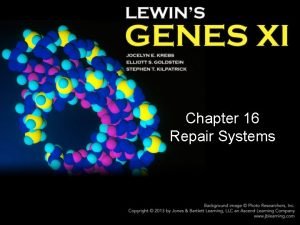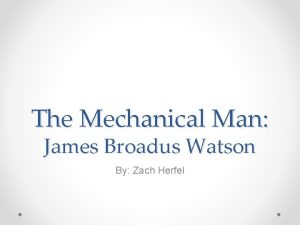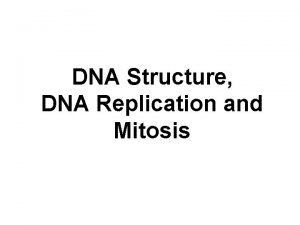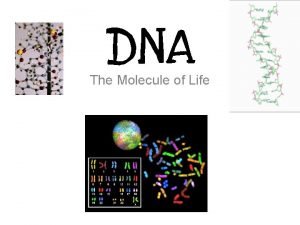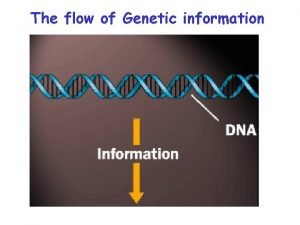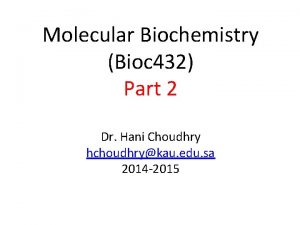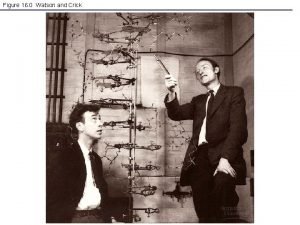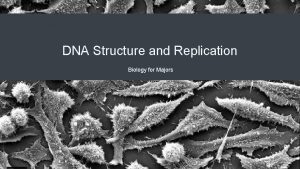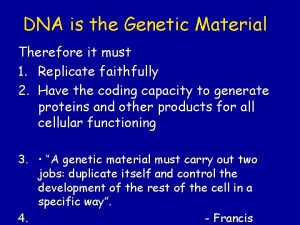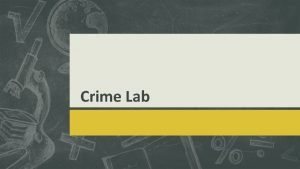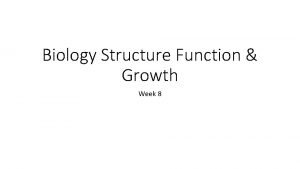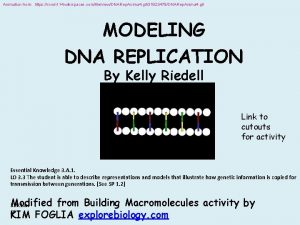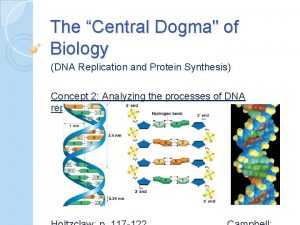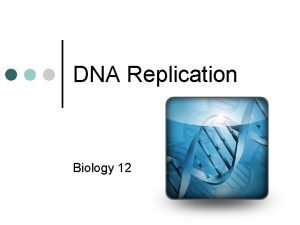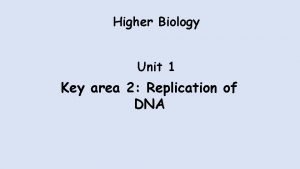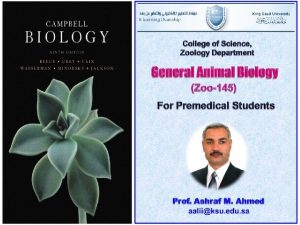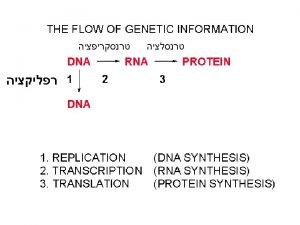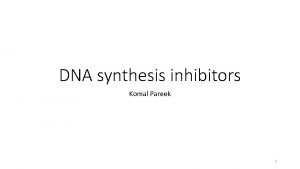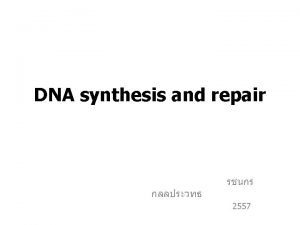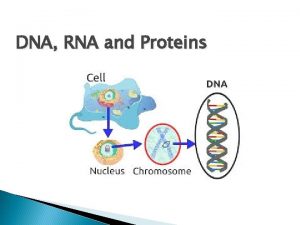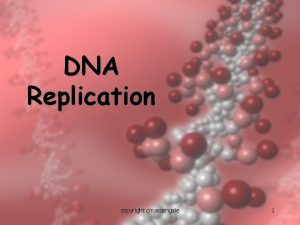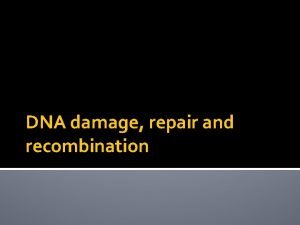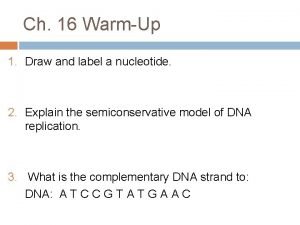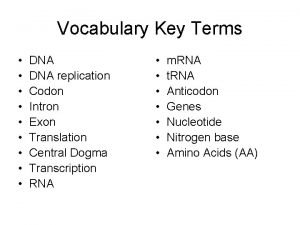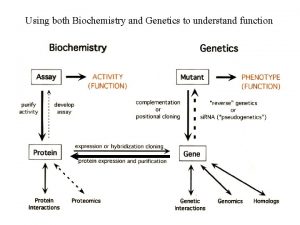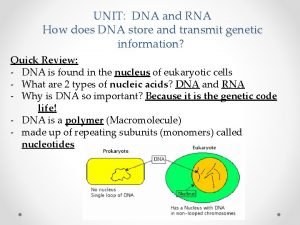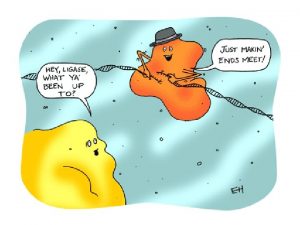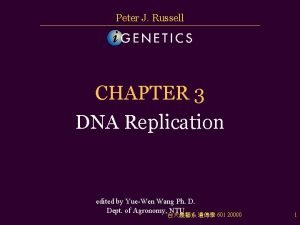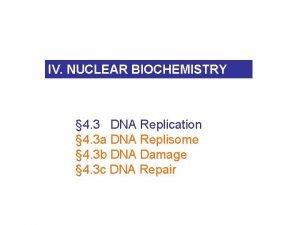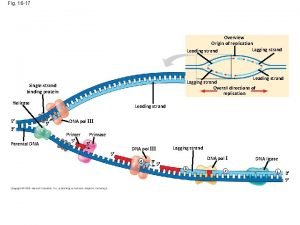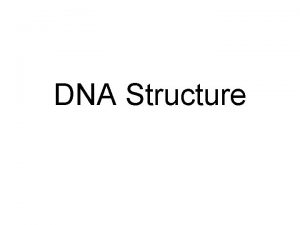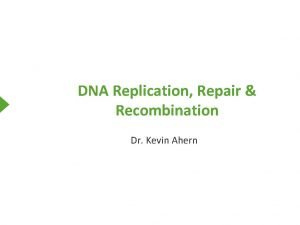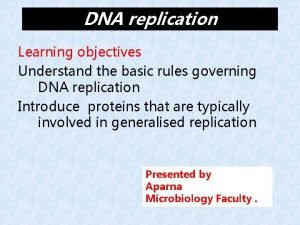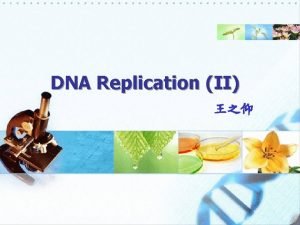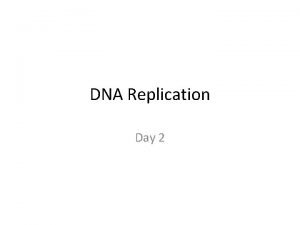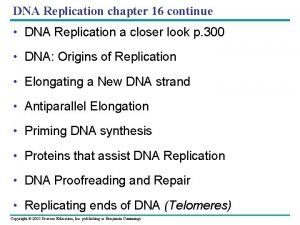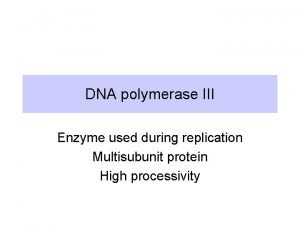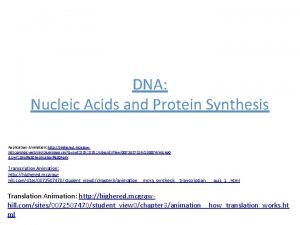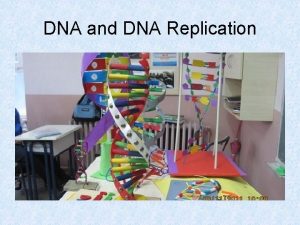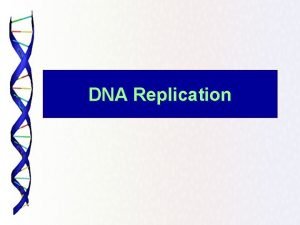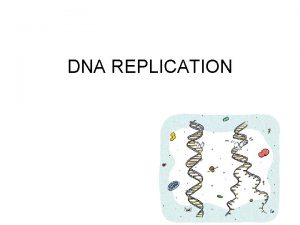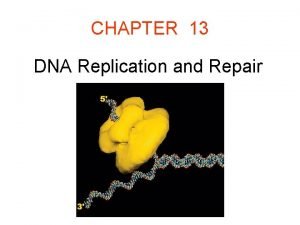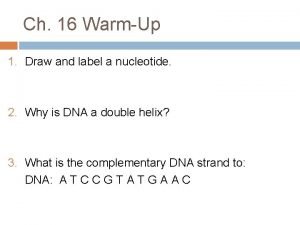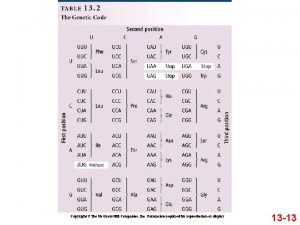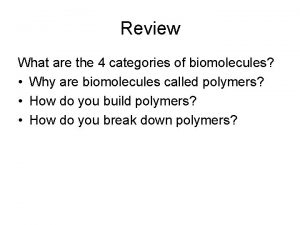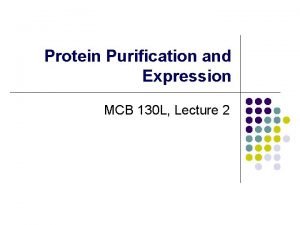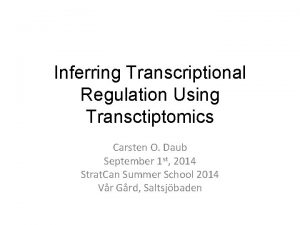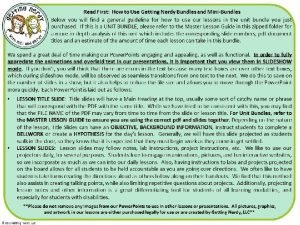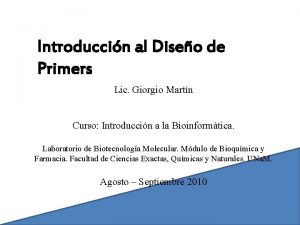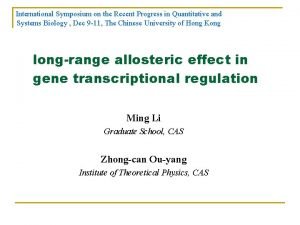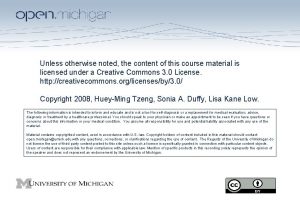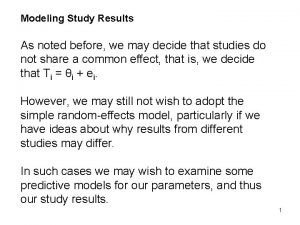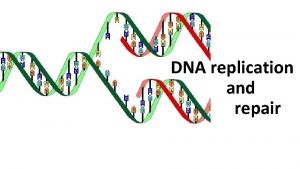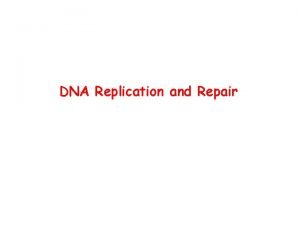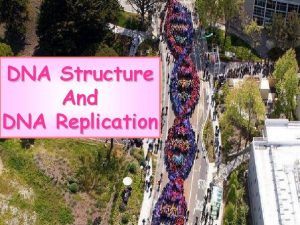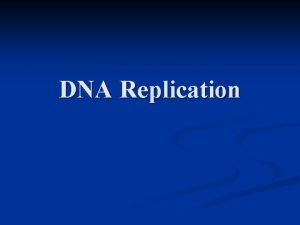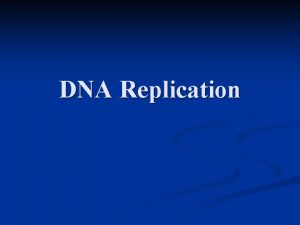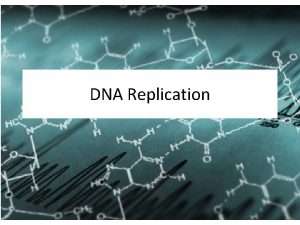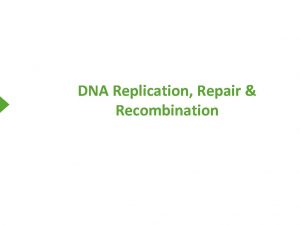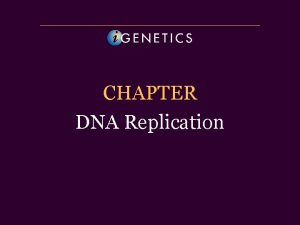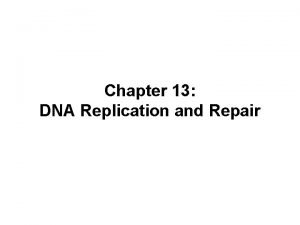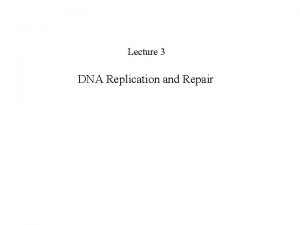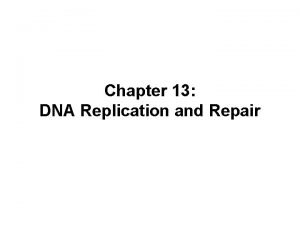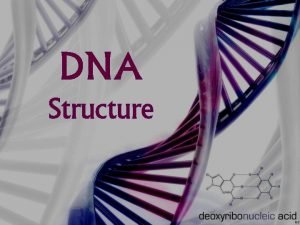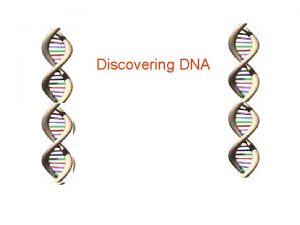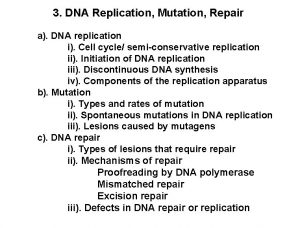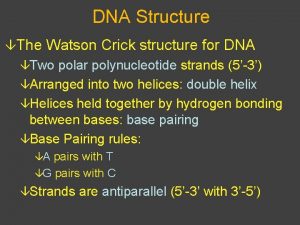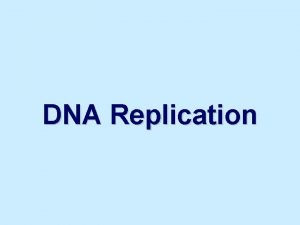DNA replication and repair Watson and Crick noted




















































































- Slides: 84

DNA replication and repair

Watson and Crick noted that the structure of DNA itself suggested a mechanism for its replication. They wrote: ”It has not escape our notice, that the specific base pairing we have postulated immediately suggests a copying mechanism”. The copying process in which a single DNA molecule becomes two identical molecules is called replication. DNA replication = DNA synthesis

Replication occurs in all living organisms and is the basis for biological inheritance. The basic mechanisms of DNA replication are similar across organisms. Copying of a cell’s DNS is not a trivial task! There about 6. 5 billion base pairs of DNA in your genome, all of which must be accurately copied when any one of your trillions of cells divides. Cell must duplicate all its DNA before cell division.

The cell cycle Cell cycle is a series of events that prepares a cell to dived. The actual division process, called mitosis. The eukaryotic cell cycle commonly is represented as 4 stages. In proliferating human cells, the 4 phases of the cell cycle proceed successively, taking from 10 to 20 hours depending on cell type and developmental state.

The cell cycle stages G 1 - S – G 2 - M 1. G 1 stage stands for GAP 1 2. S stage stands for Synthesis 3. G 2 stage stands for GAP 2 4. M stage stands for Mitosis Uder certain conditions, such as starvation or when tissue has reached its final size, cells will leave the cycle and stop dividing. This cell ”resting” state called G 0 or GAP 0. Cells in G 0 carry out all their normal functions and can reenter the cycle if conditions change.

Interphase INTERPHASE = G 1 + S+ G 2 phases Interphase consists of the parts of the cell cycle that do not involve cell division. Interphase is a very active phase of the cell cycle with many processes occurring in the cytoplasm and nucleus. The average cell spend up to 90% of it’s life in this phase. Cell division or mitosis is one phase of the cell cycle.

Interphase G 2 or growth phase ü Cells rapidly grows in size ü Synthesize proteins ü Prepare for mitosis ü Any damaged DNA or replication errors are corrected. S or synthesis phase ü DNA replication The amount of DNA in the cell has doubled M or mitosis phase ü one copy of the genomes is segregated to each daugther cell. ü The cell splits itself into two daughter cells. G 1 or growth phase ü Cells grows in size ü Synthesize proteins ü Produce organelles (ribosomes, mitochondria) ü Many of the DNA replication regulatory processes are initiated.

DNA replication The strands of the original DNA duplex separate, and each individual strain serves as a template for the synthesis of a new strand. Parent strands are the original chains of nucleotides. Daughter strands are new chain of nucleotides.

DNA parent and daughter strands. Daughter strands are complimentary to parent strands. The parent and daughter strands are antiparallel (5’-> 3’ and 3’-> 5’). Each of two daughter helices is a nearly exact copy of the parental helix, however it is not 100% the same due to mutations.

DNA replication models There are three possible models that describe the accurate creation of the daughter chains. Semiconservative: parental DNA daughter DNA Copies of replicated DNA each consists of parental strand daughter strand. Conservative: parental DNA (original) parental DNA daughter DNA After replication, parental strands remain together, daughter DNA strands form new double helix. Disruptive: Replicated DNA consists of a combination of old and new DNA.

In 1954, Matthew Meselson and Franklin Stahl proved that semiconservative model of DNA replication was correct. They have used E. coli bacteria as a model system. q They cultured bacteria in a medium containing a heavy isotope of nitrogen -15 N. 15 N q The bacteria took up 15 N and used it to synthesize new proteins and DNA. q After many generations growing in the 15 N medium, the nitrogenous bases of E. coli DNA were all labelled with heavy 15 N.

Matthew Meselson and Franklin Stahl experiment 15 N 14 N q Then, the bacteria were switched to medium containing a light isotope of nitrogen -14 N and allowed to grow for several generations. E. coli DNA made after the switch would have be made up of 14 N. q They collected samples in each E. coli generation and extracted DNA.

Matthew Meselson and Franklin Stahl experiment q They measured the density of the DNA using Cs. Cl density gradient centrifugation. Normal 14 N DNA Heavy 15 N DNA

Matthew Meselson and Franklin Stahl experiment q The samples at the start of experiment produced a single heavy 15 N DNA band. q DNA isolated after one round of replication also produced a single band, but this band was higher (between the density of the heavy 15 N and light 14 N). q Generation 2 DNA produced two bands. One was in the same position as band from the first generation. The second was higher at the position of light 14 N DNA. Their results demonstrated that DNA replicated semiconservatively.

Replisome Extreme accuracy and efficiency of DNA replication is necessary in order to preserve the integrity of the genome in successive generations. The replication machinery is a massive complex coordinating many proteins all working at the site of replication, forming the ”replisome”. § Various essential catalytic activities are present in replisomes such as the Mcm 2 -7 DNA helicase or DNA polymerases. Other components have no known catalytic activity. § A major function of these proteins is to facilitate regulation and coordination with other pathways such as the DNA damage response or chromatin assembly.

Replication fork The DNA region at which all these proteins come together to carry out synthesis of the daughter strands is called the replication fork.

Core proteins at the replication site q Topoisomerases – prevents torsion by DNA breaks q Helicases – separates 2 strands q Primase – RNA primer synthesis q Single strand binding proteins – prevent reannealing of single strands q DNA polimerase – synthesis of new strand q Tethering protein – stabilises polymerase q DNA ligase – seals nick via phosphodiester linkage

The steps of DNA replication Initiation (unwinding) § Proteins bind to DNA and open up double helix § Prepare DNA for complementary base pairing Elongation § Proteins connect the correct sequences of nucleotides into a continuous new strand of DNA Termination § Proteins release the replication complex

Initiation step DNA replication is initiated at specific points, which have been termed origins of replication. Bacterial chromosomes have a single point of origin. Eukaryotic chromosomes have multiple points of origin.

Initiation (unwinding) step The first step in DNA replication is the separation of the two DNA strands that make up the helix. DNA gyrase (class II topoisomerase) start the process of DNA unwinding by breaking (nicking) a single DNA strand. The tension holding the helix in its coiled form is released. Re plic ati on for k

Initiation (unwinding) step DNA helicase is an enzyme which unwinds the helix at origins of replication. Its doughnut like structure wraps around DNA and breaks the hydrogen bonds between the strands. In eukaryotes, Mcm 2 - 7 complex acts as a helicase.

Initiation (unwinding) step q Single- stranded binding proteins (SSB) work with helicase to keep the parental DNA helix unwound. q Single-stranded DNA is highly unstable and can form hydrogen bonds with itself (secondary structures as “hairpins). q SSB coats the unwound strands with rigid subunits that prevents strands snapping back together in a helix. q SSBs also stabilize single- stranded DNA by binding to it. In eukaryotes, heterotrimeric Replication Protein A (RPA 1 -3) acts as SSB.

Elongation step q A single strand of DNA by itself is not suitable for polymerisation. This is because the chemical reactions catalysed by DNA polymerases require a free 3' OH in order to initiate nucleotide chain elongation. q DNA polymerase can not start chain elongation de novo. It requires a pre-existing chain of nucleotides.

Elongation step This problem is solved by RNA primase (a type of RNA polymerase). RNA primase synthesizes and adds on each unwound DNA strand a short (5 -10 nucleotides long) RNA sequences (RNA primers) that are complimentary to DNA sequence. DNA polymerase alpha (Pol α) extends the RNA primer with deoxynucleotides for another 20 nucleotides, forming a mixed RNA- DNA primer. Pol α starts a new DNA strand.

Elongation step DNA polymerases q DNA polymerases are the main working horses of the replication process. The main DNA polymerases involved in eukariotyc cell replication: DNA epsilon DNA delta DNA alpha q DNA polymerases have catalytic 5’-3’ polymerase activity. q DNA polymerases have also 3’-5’ exonuclease activity, allowing it to back up and remove nucleotides, correcting errors.

Enzymatic activities of polymerases • 5’-3’ polymerase activity 5’-AAGTCACC-3’ +G 3’-TTCAGTGGCAAGC-5’ 5’-AAGTCACCG-3’ 3’-TTCAGTGGCAAGC-5’ 5’-3’ polymerase activity is present in all DNA and RNA polymerases It will NEVER be a 3’-5’ polymerase activity!

Enzymatic activities of polymerases • 3’-5’ exonuclease (editing) activity A -3’ -A 5’-AAGTCAC 3’-TTCAGTGGCAA-5’ 5’-AAGTCAC-3’ 3’-TTCAGTGGCAA-5’ Normally, only one mismatched nucleotide is removed 3’-5’ exonuclease activity is present in most (but not all) DNA and RNA polymerases. It is not present in DNA polymerase alpha.

DNA polymerization reaction 5' end of strand O P OH CH 2 O P O O OH O 3’ OH group is needed to react with the phosphate group on the 5’ end of the next nucleotide to form a phosphodiester bond. OH CH 2 Base O CH 2 P Base O P OH CH 2 Base O OH O P O OH 3' P OH O OH P O Synthesis reaction OH 5' CH 2 3' OH O P OH CH 2 O + O OH OH P P H 2 0 + O OH OH Base OH 3' end of strand

DNA polymerase structure The overall architecture of a DNA polymerase resembles a human right hand consisits of three domains: palm, fingers and thumb. q Template DNA is threaded through the palm. q Thumb and fingers wrapped around the DNA. q The finger domain function to bind the NTPs with the template nitorgenious base. q The thumb domain plays a role in translocation and positioning of DNA.

However, the conformation of DNA polymerases does not allow for their stable interaction with the template DNA. q To strengthen the interaction between template and polymerase, DNA sliding clamps have evolved. q This sliding clamp is a homotrimer – PCNA (proliferating cell nuclear antigen), which form a ring structure. q The daugther duplex DNA passes through the PCNA central hole. That enables DNA Pol epsilon and delta to remain stably associated with a single template strand for thousands of nucleotides. q PCNA- dependent stabilization of DNA polymerases enhances polymerase processivity up to 1000 - fold.

The Leading and lagging strands the leading strand When the two parent DNA strands are separated to begin replication, one strand is oriented in the 5’ to 3’ direction while the other strand is oriented in the 3’ to 5’ direction. 5’ 3’ the lagging strand Two daughter strands must run in opposite directions: For one daughter strand the direction of chain growth must be 5’ to 3’ direction. This is the leading strand. For other daughter strand the direction of chain growth must be 3’ to 5’ direction. This is the lagging strand.

The Leading and lagging strands the leading strand 5’ 3’ the lagging strand Since DNA polymerases can only make DNA in the 5' to 3' direction, this poses a problem during replication. This means that the lagging and leading strands synthesize through different methods.

ε q Only the leading strand will have a free 3’ OH group at the point of bifurcation. This will permit sequential addition of nucleotides and continuous elongation in the same direction in which the replication fork moves. q RNA primase adds the first nucleotides to the nascent chain. q DNA polymerase epsilon sits near the replication fork, moving as the fork does and adding nucleotides one after the other, preserving antiparallel orientation. q The nucleotides are added in the 5’ to 3’ direction.

The lagging strand replication The 5’ to 3’ direction of synthesis of the lagging strand is in opposite direction to that in which the replication fork moves. As a result, synthesis of the lagging strand has to be accomplished in steps. The lagging strand replicates in a small fragments , called Okazaki fragments are stretches of 100 - 200 nucleotides in humans that are synthesized in the 5’ to 3’ direction away from replication fork. This type of replication is called discontinuous.

§ Every 100 -200 nucleotides, RNA primers are added by a primase. δ § DNA polymerase δ synthesize lagging strand (Okazaki fragment) in 5’ – 3’ direction. δ δ § DNA polymerase δ will let go of DNA once it meets the next RNA primer. δ § Ribonuclease H will recognize RNA primer and cut it out. § DNA ligase closes the gaps in the DNA strand.

Replication problem at the ends of linear chromosomes. q Eukaryotes have linear chromosomes, and linear chromosomes have an end problem. q Problem caused by the fact that DNA polymerase can only add nucleotides to the 3’ end of preexisting polynucleotide. q DNA replication is unable to reach the very end of the chromosomes.

Replication problem at the ends of linear chromosomes. q DNA replication ends at the telomere region of repetitive DNA close to the ends. q Telomeres contain short, repetitive sequences, usually TTAGGGG. q This sequence is repeated approximately 2, 500 times in humans q Telomeres length is about 15000 base pairs.

Telomers q Telomeric DNA protects the organism's genes from being eroded through successive rounds of DNA replication q Telomeric DNA aids in preventing separate chromosomes from fusing q Telomeric DNA and associated proteins prevent the ends from activating the cell's systems for monitoring DNA damage

The leading strand synthesis can be completed. The lagging strand synthesis cause the end problem.

Telomerases To prevent the loss of genetic information due to chromosome shortening, additional DNA sequences are attached to the ends of telomeres. In 1984, Carol Greidner and Elizabeth Blackburn discovered an enzyme called telomerase, that prevents chromosome shortening. They received the 2009 Nobel Prize in physiology or medicine for their discovery. The telomerase contains a piece of RNA associated with its protein.

Telomerase produce DNA in direction 3’ to 5’.

Is telomerase always active? • Active in children, germ and stem cells of adults • Inactive in somatic cells of adults • So, chromosomes actually get shorter – this is why we get old and die. . . • In humans, average telomere length declines from about 11 000 base pairs at birth to less than 4000 base pairs in old age. • Activation of telomerase in adult mice increase their life span. • Telomerase is active in most tumours.

Some differences in replication among prokaryotes and eukaryotes Reasons: • 1. Eukaryotic chromosomes are typically much longer than prokaryotic • 2. Eukaryotic chromosomes are linear, not circular

Prokaryotic vs. eukaryotic DNA replication Location q DNA is present as a DNA-protein complex called nucleoid. q DNA is located inside the nucleus. q The DNA replication occurs in the cytoplasm of the cell. q The nucleus is the site for DNA replication.

Prokaryotic vs. eukaryotic DNA replication Stage of cell division q Since prokaryotes do not have a nucleus, they undergo a simple division called binary fission (“splitting in two”). q Cell division is more complicated. The nucleus is divided in a process called mitosis. q DNA replication is the first step of cell division. q DNA replication occurs during the synthesis (S) phase of cell cycle.

Prokaryotic vs. eukaryotic DNA replication Initiation of replication q DNA contain a single origin of replication and a single replicon (the DNA region between origin of replication and termination site). q Due to the high amount of material to be copied, DNA molecule contains multiple origins of replication (over 1000) on each chromosome. q Each chromosome has several replicons. q Origin of replication sites is about 100 -200 or more nucleotides. q Each origin of replication is formed of about 150 nucleotides.

Prokaryotic vs. eukaryotic DNA replication Okazaki fragments q Okazaki fragments are long, with the typical length about 1000 - 2000 nucleotides q Okazaki fragments ranges between 100 and 200 nucleotides.

Main differences among eukaryotic and prokaryotic replication forks • In eukaryotes RNA primer is first extended by DNA Pol a, then by DNA Pol d or ε. In prokaryotes extension is done solely by DNA Pol III. • In eukaryotes, RNA primer is excised by RNase H and then gap filled by DNA Pol. In prokaryotes DNA Pol I is able to both excise RNA and fill in DNA. Overall the proteins involved in replication have similar functions in eukaryotic and prokaryotic cells, but have different names.

Prokaryotic vs. eukaryotic DNA replication Termination of replication The termination occurs at specific termination sites in both cells. q A single termination site is present midway between the circular chromosome. The two replication forks meets at this site, halting the DNA replication. q DNA has several termination sites along the chromosome. q A part of DNA present at the ends of chromosomes does not get replicated. q The lagging strand is shorter than the leading strand.

Speed of DNA replication q The genome of complex eukaryotes is huge and the process of DNA replication should be incredibly fast. q The speed of DNA replication for the humans is about 50 nucleotides per second per replication fork. This is a low speed comparing to the speed of the bacterial DNA replication. q It would take a month to replicate a chromosome of 250 million base pairs. q Human genome can be copied only in a few hours because many replication forks take place at the same time (multiple origins of replication). q The bacteria genome contains 4. 7 million base pairs. The speed of DNA replication in bacteria is much higher about 1000 nucleotides per second, and thus is done in no more than 40 minutes. That is a reason why during process of bacterial replication the rate of errors much higher.

Failure to complete DNA replication leads to chromosome breaks, translocation, loss of heterozygosity or cell death.

Mechanisms for maintaining DNA integrity DNA damage and repair

DNA damage and repair • Process of DNA replication during cell division is prone to error. • The rate at which DNA polymerase adds incorrect nucleotides during DNA replication is a major factor in determining the spontaneous mutation rate in an organism. • The frequency at which human DNA undergoes lasting, uncorrected errors range from 1 x 10 -4 to 1 x 10 -6 mutations per gamete for a given gene. ü This means that we would expect to find one mutation at a specific locus per one million gametes.

Mutation rates can differ between the organisms • The highest per base pair per generation mutation rates are found in viruses. • DNA viruses have mutation rates between 10− 6 to 10− 8 mutations per base per generation, and RNA viruses have mutation rates between 10− 3 to 10− 5 per base per generation. • RNA virus mutation rates are especially high partially due to not having a proofreading mechanism.

Environmental agents that damage DNA integrity Radiations q Ionizing radiation – gamma rays and x-rays q Ultraviolet rays, especially the UV-C rays (260 nm) that are absorbed strongly by DNS and the longer UV-B that penetrates the ozone shield q Highly reactive oxygen radicals produced during normal cell respiration and other biochemical pathways

Environmental agents that damage DNA integrity Chemicals q Plant and microbial products, e. g. the Aflatoxin produced in moldy peanuts q Aromatic hydrocarbons, such as found in cigarette smoke q Chemicals used in chemotherapy, especially for cancer treatment. It has been estimated that an individual cell can suffer up to one million DNA changes per day.

DNA repair mechanisms q. Cells have evolved a number of mechanisms to detect and repair the various types of damage that can occur to DNA, no matter whether this damage is caused by the environment or by errors in replication. q. DNA repair processes exist in both prokaryotic and eukaryotic organisms, and many of the proteins involved have been highly conserved throughout evolution.

Mechanisms used by cells to correct replication errors • Proofreading ücorrects errors during DNA replication • Mismatch repair üfixes mispaired bases right after DNA replication

DNA proofreading DNA polymerase makes about 1 in 10000 base pairing errors. During DNA replication, most DNA polymerases "check their work" with each base that they add. This process is called proofreading.

DNA mismatch repair q Immediately after DNA replication, any remaining mispaired bases (that were not fixed during proofreading) can be detected and replaced in a process called mismatch repair. q Mismatch repair can also detect and correct small insertions and deletions that happen when the polymerases "slips, " losing its footing on the template.

A second protein complex cuts the DNA near the mismatch, and more enzymes chop out the incorrect nucleotide and a surrounding patch of DNA.

DNA mismatch repair • When two bases are mispaired (like the G and T), how the proteins involved in DNA repair can tell which of the two base should be removed and replaced? • In bacteria, original and newly made strands of DNA can be told apart by a feature called methylation state. An old DNA strand will have methyl (−CH 3) groups attached to some of its bases, while a newly made DNA strand will not yet have gotten its methyl group. • In eukaryotes, the processes that allow the original strand to be identified involve recognition of nicks (single-stranded breaks) that are found only in the newly synthesized DNA.

Diseases caused by impaired mismatch repair process q Hereditary nonpolyposis colorectal cancer (HNPCC) or Lynch syndrome, is an inherited disorder that increases the risk of many types of cancer, particularly colorectal cancer. People with Lynch syndrome also have an increased risk of cancers of the stomach, small intestine, liver, ovarian, upper urinary tract, brain, and skin. q. The hereditary mutation of one of the five DNA mismatch repair genes (MSH-2, MSH-6, MLH-1, PMS-1 ve PMS-2) results in disease. Since mismatched bases are not repaired in the cells of people with this syndrome, mutations accumulate much more rapidly than in the cells of an unaffected person. q. Accounts for 2 -5% of all colon cancers

DNA damage and repair mechanisms • DNA can be damaged at almost any point in a cell's lifetime, not just during replication. • DNA is getting damaged all the time by outside factors like UV light, chemicals, X-rays and spontaneous chemical reaction. • Our cells have repair mechanisms to detect and correct many types of DNA damage.

Repair processes that help fix damaged DNA q Direct reversal Ø Some DNA-damaging chemical reactions can be directly "undone" by enzymes in the cell. üphotoreactivation ümethyl group removal q Excision repair Ø Damage to one or a few bases of DNA is often fixed by removal (excision) and replacement of the damaged region: ü base excision repair- the damaged base is removed ü nucleotide excision repair- a patch of nucleotides is removed. q Double-stranded break repair: Øthere are wo major pathways: ü non-homologous end joining (NHEJ) ühomologous recombination, used to repair double-stranded breaks in DNA (that is, when an entire chromosome splits into two pieces).

Direct reversal DNA damage repair q DNA damage is fixed simply by reversing the chemical reaction that caused it. q DNA damage often just involves an extra group of atoms getting attached to DNA through a chemical reaction.

Direct reversal DNA damage repair Methyl group removal q Guanine can undergo a reaction that attaches a methyl –CH 3 group to an oxygen atom in the base. The methyl-bearing guanine, if not fixed, will pair with thymine (T) rather than cytosine (C) during DNA replication. q MGMT- O-6 -methylguanine-DNA methyltransferase and Fe(II)/α-ketoglutarate dioxygenases (Fe. KGDs) are enzymes that can remove the methyl group, reversing the reaction and returning the base to normal. ü The methyl group is transferred to the enzyme itself, inactivating the protein.

Direct reversal DNA damage repairphotoreactivation UV radiation causes formation of thymine dimers These pyrimidine covalently linked (C-C or T-T) dimers arise on the same strand of DNA.

Direct reversal DNA damage repairphotoreactivation q. Both of these lesions distort DNA's structure, introducing bends or kinks and thereby impeding transcription and replication. q. One "hot spot" for UV-induced damage is found within a commonly mutated oncogene, the p 53 gene.

Direct reversal DNA damage repairphotoreactivation q In photoreaction process, an enzyme – DNA photolyase reverses the dimerization reaction by breakdown the covalent bond upon absorbing blue light. q Photoreaction occurs in bacteria, yeast, insects, plants and some vertebrates, but is no longer working in humans.

Repair processes that help fix damaged DNA q Direct reversal Ø Some DNA-damaging chemical reactions can be directly "undone" by enzymes in the cell. üphotoreactivation ümethyl group removal q Excision repair Ø Damage to one or a few bases of DNA is often fixed by removal (excision) and replacement of the damaged region: ü base excision repair- the damaged base is removed ü nucleotide excision repair- a patch of nucleotides is removed. q Double-stranded break repair: Øthere are wo major pathways: ü non-homologous end joining (NHEJ) ühomologous recombination, used to repair double-stranded breaks in DNA (that is, when an entire chromosome splits into two pieces).

Nucleotide excision repair (NER) q Nucleotide excision repairs DNA injures caused by UV radiation or carcinogenic substances like those found in cigarette smoke. q In eukaryotes, this complex process relies on the products of approximately 30 genes. The XP genes are among them.

Nucleotide excision repair (NER) associated diseases q Defects in some of the genes involved in NER have been shown to cause the human disease ü xeroderma pigmentosum (XP), üpredisposition to development of skin cancer (risk of skin cancer is elevated about a thousand fold over normal).

Nucleotide excision repair (NER) associated diseases Xeroderma pigmentosum (XP) q XP -autosomal recessive disorder has a frequency of 1 in every 250, 000 individuals of all races and ethnic groups. q. People with xeroderma pigmentosum are extremely sensitive to UV light. They develop severe sunburns from just a few minutes in the sun, and about half will get skin cancer by the age of 10 unless they avoid the sun. q. When NER process doesn't work, thymine dimers and other forms of UV damage can't be repaired leading to genetic instability and skin cancer.

Nucleotide excision repair (NER) associated diseases Xeroderma pigmentosum q. The molecular basis of XP has been attributed to mutations in any of the eight XP genes. ØThe XPA, XPC and XPE proteins are needed to recognize the photoproducts in DNA and initiate the repair process. ØXPB and XPD are part of the basal transcription factor. They are helicases that create the DNA strand opening. ØXPG and XPF are endonucleases that allow resynthesis using nondamaged strand as template.

Repair processes that help fix damaged DNA q Direct reversal Ø Some DNA-damaging chemical reactions can be directly "undone" by enzymes in the cell. üphotoreactivation ümethyl group removal q Excision repair Ø Damage to one or a few bases of DNA is often fixed by removal (excision) and replacement of the damaged region: ü base excision repair- the damaged base is removed ü nucleotide excision repair- a patch of nucleotides is removed. q Double-stranded break repair: Øthere are wo major pathways: ü non-homologous end joining (NHEJ) ühomologous recombination, used to repair double-stranded breaks in DNA (that is, when an entire chromosome splits into two pieces).

Base excision repair (BER) q BER is the predominant mechanism that handles the spontaneous DNA damage caused by free radicals and other reactive species generated by metabolism. § Bases can become oxidized, alkylated, or hydrolyzed through interactions with these agents. § The deamination of cytosin to uracil happens at a significant rate in cells. Uracil will pair with adenine rather than cytosine, so an uncorrected cytosine-to-uracil change can lead to a mutation. • Deamination converts adenine to hypoxanthine, which hydrogen bonds to cytosine rather than to thymine.

q A group of enzymes called glycosylases play a key role in base excision repair. Each glycosylase detects and removes a specific kind of damaged base. AP (apurinic/apyrimidinic) endonuclease

Repair processes that help fix damaged DNA q Direct reversal Ø Some DNA-damaging chemical reactions can be directly "undone" by enzymes in the cell. üphotoreactivation ümethyl group removal q Excision repair Ø Damage to one or a few bases of DNA is often fixed by removal (excision) and replacement of the damaged region: ü base excision repair- the damaged base is removed ü nucleotide excision repair- a patch of nucleotides is removed. q Double-stranded break repair: Øthere are wo major pathways: ü non-homologous end joining (NHEJ) ühomologous recombination, both used to repair double-stranded breaks in DNA (that is, when an entire chromosome splits into two pieces).

Ionizing radiation DNA damage repair Ionizing (high energy) radiation introduce highly deleterious double-strand breaks in DNA molecule (splitting a chromosome in two). They • interfere with transcription or replication • can lead to chromosomal rearrangements- pieces of one chromosome become attached to another chromosome. Genes are disrupted in this process, leading to hybrid proteins or inappropriate activation of genes. • If the break is not repaired large segments of chromosomes, and the hundreds of genes they contain, may be lost. • A number of cancers are associated with such rearrangements.

Non-homologous end joining (NHEJ) • The process is initiated by the binding of the DNA- protein kinase (DNA-PK) complex (KU 70/KU 80 heterodimer) to the DNA ends. • KU dimer recruits DNA-PKcs catalytic subunit to form an active DNA-PK holoenzyme. • DNA-PK activation helps the recruitment of multiple proteins involved in the limited DNA end-processing (Artemis, pol μ, pol λ, and TDK) required to generate ligatable DNA ends. • Ligation is mediated exclusively by the LIG 4/XRCC 4 complex and is assisted by the ligation mediator XLF. • At the end of this process the DNA integrity at the break is restored, but the DNA sequence at the junction may be altered. NHEJ is an error-prone DSB repair mechanism.

Homologous recombination (HR) • In this process, the two homologous chromosomes come together, and the undamaged region of the homologue or chromatid is used as a template to replace the damaged region of the broken chromosome. • DNA ends are first processed in order to create single-strand overhangs, a process that is likely mediated by the MRN (Mre 11/Rad 50/Nbs 1) complex. • Rad 51, Rad 52, and RPA associate with these overhangs, followed by the formation of a joint molecule by the damaged and undamaged strands. • Template guided DNA synthesis and resolution of the two strands then complete repair of the DSB. • Homologous recombination is “cleaner” than non-homologous end joining and does not usually cause mutations.

q Many human diseases are associated with deficiencies in DNA DSB repair and can be characterized by neuropathology, immune deficiency, growth retardation or predisposition to cancer. • Ataxia-telangiectasia or Louis–Bar syndrome is a rare, neurodegenerative, autosomal recessive disease causing severe disability. • Ataxia refers to poor coordination and telangiestasia to small dilated blood vessels, both of which are hallmarks of the disease. A-T affects many parts of the body: • It impairs certain areas of the brain causing difficulty with movement and coordination. • It weakens the immune system , causing a predisposition to infection. • It prevents repair of broken DNA, increasing the risk of cancer. A-T is caused by a defect in the ATM gene. ATM serine/threonine kinase (ATM), is a serine/threonine protein kinase that is recruited and activated by DNA double- strand breaks. It phosphorylates several key proteins that initiate activation of the DNA damage repair.

q. Mutations in an organism's DNA are a part of life. q. The errors that slip through the DNA repair processes may sometimes be associated with disease, but they are also a source of variation that can be selected upon evolution and natural selection as beneficial to life.
 Bioflix activity dna replication nucleotide pairing
Bioflix activity dna replication nucleotide pairing Chargaff rule definition
Chargaff rule definition Watson and crick thieves
Watson and crick thieves Watson-crick
Watson-crick Dna a
Dna a Polisacridos
Polisacridos Watson health francisco 1b
Watson health francisco 1b Watson strand crick strand
Watson strand crick strand Watson strand crick strand
Watson strand crick strand Replication fork
Replication fork Chapter 11 dna and genes
Chapter 11 dna and genes Depurination
Depurination Rec a
Rec a John watson james broadus watson
John watson james broadus watson John broadus watson emma watson
John broadus watson emma watson Experimento de watson
Experimento de watson John b. watson emma watson
John b. watson emma watson Haploid vs diploid
Haploid vs diploid Dna structure and replication packet answer key
Dna structure and replication packet answer key Dna replication transcription and translation
Dna replication transcription and translation Nature of dna replication
Nature of dna replication Dna polymerase proofreading
Dna polymerase proofreading Dna replication steps
Dna replication steps Dna replication is semi-conservative
Dna replication is semi-conservative Okazaki fragments
Okazaki fragments 3 models of dna replication
3 models of dna replication Major enzymes in dna replication
Major enzymes in dna replication Antiparallel in dna replication
Antiparallel in dna replication Dna jeopardy
Dna jeopardy Replication fork labeled
Replication fork labeled Missy baker
Missy baker What process is this
What process is this Nucleoside triphosphate in dna replication
Nucleoside triphosphate in dna replication Bioflix dna replication
Bioflix dna replication Restaurant analogy
Restaurant analogy Fork dna
Fork dna Dna replication higher human biology
Dna replication higher human biology Why is dna replication considered semiconservative
Why is dna replication considered semiconservative Dna replication pearson
Dna replication pearson Dna replication direction 5' 3'
Dna replication direction 5' 3' Dna replication in bacteria occurs
Dna replication in bacteria occurs Dna replication
Dna replication Helicaee
Helicaee Dna replication comic strip
Dna replication comic strip S phase
S phase Accuracy of dna replication
Accuracy of dna replication Bioflix dna replication
Bioflix dna replication Dna replication
Dna replication Dna synthesis at replication fork
Dna synthesis at replication fork Dna replication phschool
Dna replication phschool Chapter 13-the molecular basis of inheritance
Chapter 13-the molecular basis of inheritance Dna replication importance
Dna replication importance Enzyme involved in dna replication
Enzyme involved in dna replication In eukaryotes dna replication occurs in
In eukaryotes dna replication occurs in Dna replication fork
Dna replication fork Dna replication
Dna replication Semiconservative dna replication
Semiconservative dna replication Replication fork definition
Replication fork definition Replication fork
Replication fork Orc dna replication
Orc dna replication Significance of dna replication
Significance of dna replication Replication fork
Replication fork Dna replication
Dna replication Part c - the replication bubble and antiparallel elongation
Part c - the replication bubble and antiparallel elongation Summary of dna replication
Summary of dna replication Dna replication animation mcgraw hill
Dna replication animation mcgraw hill Dna replication
Dna replication The principle enzyme involved in dna replication is called
The principle enzyme involved in dna replication is called Dna replication fork animation
Dna replication fork animation Dna replication is considered semiconservative because
Dna replication is considered semiconservative because Bioflix dna replication
Bioflix dna replication Francis crick nationality
Francis crick nationality Enzyme
Enzyme Adenine thymine cytosine and guanine
Adenine thymine cytosine and guanine Francis crick
Francis crick Francis crick
Francis crick Francis crick
Francis crick Primers degenerados
Primers degenerados Smar crick
Smar crick Smrt crick
Smrt crick Cristen chin model
Cristen chin model Unless noted otherwise
Unless noted otherwise Huey-ming tzeng
Huey-ming tzeng Noted
Noted Example of objective reality
Example of objective reality

